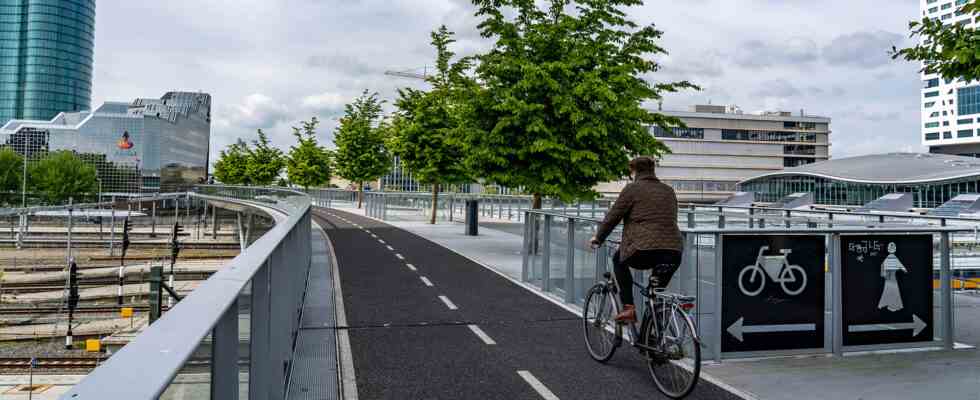Status: 07.08.2022 5:17 p.m
When it comes to urban development, the Dutch city of Utrecht relies entirely on bicycles – driving a car should be as unattractive as possible. How does that go down with the citizens and the economy?
In the shade of treetops, cyclists cycle along a wide canal that frames the historic city center in the Dutch city of Utrecht. On this summer’s day, the area seems idyllic, the people relaxed. City planner Marijn Kik is proud of the fact that this street now symbolizes a transport strategy that has been carefully considered over the years.
“Just a few years ago, this was a six-lane expressway for cars,” he explains. “We then closed it, turned it into a bicycle street, created a canal and gave people back a part of their city.”
With around 360,000 inhabitants, the fourth-largest city in the Netherlands is all about cycling and investing heavily in the expansion of the cycling infrastructure.
According to the city planners, the old town of Utrecht should retain its charm – also with as little traffic as possible.
Image: picture alliance / Jochen Tack
Renaissance of the bike
The coalition elected in 2010 wants to meet the climate protection goals and transform the city into a sustainable living space. “Utrecht – everyone rides a bike” is the name of one of the many action papers that have significantly boosted the proportion of cyclists over the past ten years. Today the city has about 125,000 cyclists – per day.
According to Marijn Kik, 60 percent of all journeys in Utrecht are made by bike, in Berlin it is only about 13 percent. A success that the city is willing to pay a lot for: Between 2015 and 2020 alone, it invested around 168 million euros in the expansion of the bicycle infrastructure and parking spaces, financed from taxes.
Nevertheless, the change to the wheel is profitable in the long run. The city planner emphasizes that the bicycle boom has opened up a whole new market, from bicycle sales to workshops. The fact that the city center can be reached quickly and easily by bike also leads to an increase in retail sales.
In return, the business owners accept limitations. For example, goods can only be delivered in the early hours of the morning – only if the areas in front of the shops are not yet full of bikes. Service providers such as craftsmen or couriers are increasingly driving their cargo bikes to customers in order to avoid having to look for a parking space altogether.
Image: picture alliance / Jochen Tack
“Cars only guests”
Five main cycle routes connect all parts of the city with each other. The “Fietsstraaten” with blue logo on red asphalt is hard to miss. Traffic lights are more bicycle-friendly, bicycle bridges and underpasses close gaps in the traffic network, many streets are completely car-free.
“Cars are only guests on the road along the canal,” says city planner Kik, describing a narrow strip where cars can drive at a maximum of 30 kilometers per hour and bicycles cannot be overtaken. “Well”, he grins, “driving in Utrecht is not pleasant”.
That too is a strategy: don’t completely rule out cars, but make it as difficult as possible for them. Most cars therefore voluntarily switch to the ring road outside the city.
Lots of space for bikes
In recent years, a highly modern bicycle parking garage has been built under the station forecourt, which is constantly being expanded. With currently 12,500 bicycle parking spaces on three floors, it is the largest in the world. Scanned with a chip, a digital guidance system leads to the next available parking space. The direct access to the main train station is primarily intended to encourage commuters to travel by bike and train.
That’s what student Hugo, who uses the car park every day, does: “I study in Amsterdam but live in Utrecht. In the morning I cycle to the car park, park my bike and take the train to Amsterdam.”
The bicycle garage is guarded, open 24 hours a day and free of charge for the first 24 hours. The city has created such guarded bicycle parking spaces in other central locations.
Before parking, there is the formality: Before they can park their two-wheeler for 24 hours free of charge, users of the Utrecht car park must check in properly.
Image: REUTERS
Vision of a ten minute city
Utrecht is a fast growing city. In the past ten years alone, the population has increased by 50,000. “We’re far from finished, there’s still a lot of work ahead of us,” says Kik, giving an outlook on the next few years.
In order to do justice to the increasing population, the city has to define new standards. A new mobility plan sets far-reaching goals by 2040: Utrecht is to become a “ten-minute city”. Apartments, shops and other facilities would then be located at public transport hubs so that they could be easily reached on foot or by bike. No journey should take longer than ten minutes.
The ride through the three floors of the car park is suitable for bicycles – with wide paths.
Image: picture alliance / Jochen Tack
Germany is following suit
In Germany, too, the need for a well-developed cycling infrastructure is increasing. According to the Federal Ministry of Transport’s “National Cycling Plan 3.0”, 60 percent of Germans plan to cycle more in the future.
With a volume of around 155 million euros, the federal government is therefore funding innovative model projects in cycling until 2026. “Bike-friendly cities are considered particularly livable cities,” writes the Federal Ministry of Transport in its report.
People in Utrecht have known that for a long time. City planner Marjin Kik has never had a car, in his city the wheel is enough.

